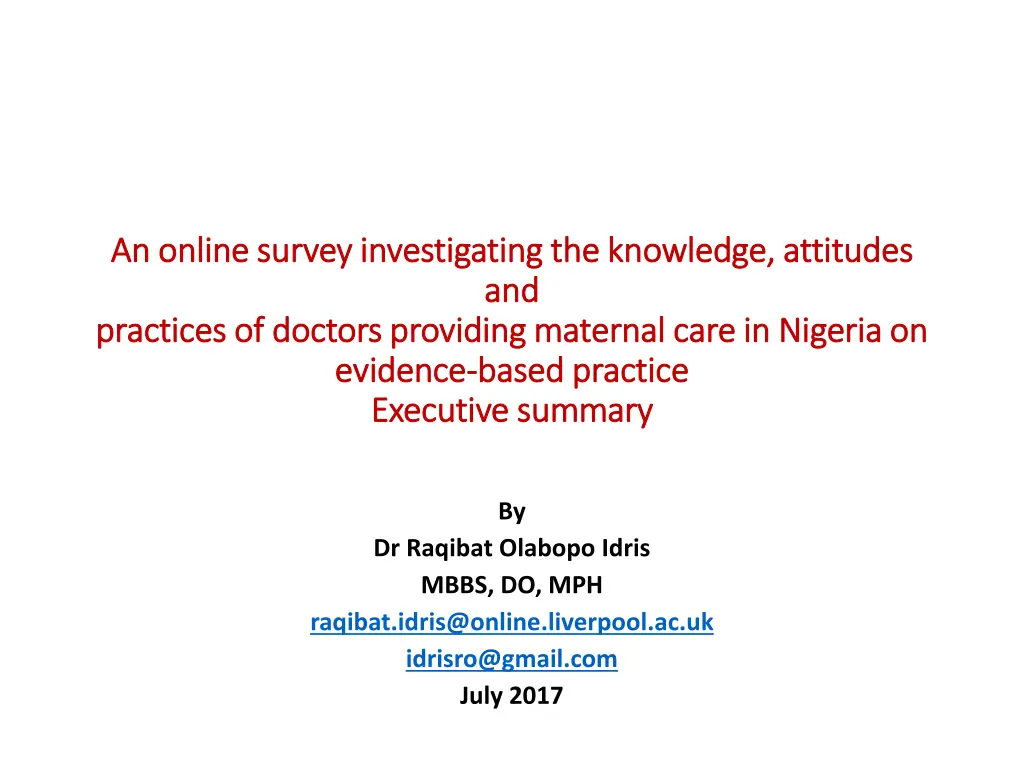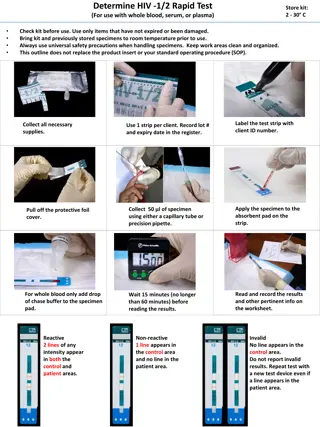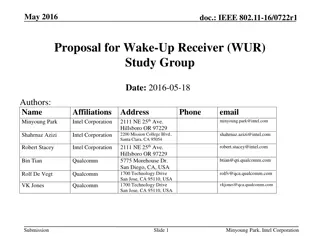
Maternal Care Practices in Nigeria
Explore the knowledge, attitudes, and practices of doctors providing maternal care in Nigeria regarding evidence-based practice. Understand the need for evidence-based care to improve maternal and neonatal outcomes in a country with high maternal mortality rates. Learn about the barriers and facilitators to implementing evidence-based practice in maternal care.
Download Presentation

Please find below an Image/Link to download the presentation.
The content on the website is provided AS IS for your information and personal use only. It may not be sold, licensed, or shared on other websites without obtaining consent from the author. If you encounter any issues during the download, it is possible that the publisher has removed the file from their server.
You are allowed to download the files provided on this website for personal or commercial use, subject to the condition that they are used lawfully. All files are the property of their respective owners.
The content on the website is provided AS IS for your information and personal use only. It may not be sold, licensed, or shared on other websites without obtaining consent from the author.
E N D
Presentation Transcript
An online survey investigating the knowledge, attitudes An online survey investigating the knowledge, attitudes and and practices of doctors providing maternal care in Nigeria on practices of doctors providing maternal care in Nigeria on evidence evidence- -based practice based practice Executive summary Executive summary By Dr Raqibat Olabopo Idris MBBS, DO, MPH raqibat.idris@online.liverpool.ac.uk idrisro@gmail.com July 2017
This is an executive summary of the report of a dissertation on the knowledge, attitudes and practices of doctors providing maternal care in Nigeria on evidence-based practice, submitted in partial fulfilment of the requirement for the degree of Master of Public Health, The University of Liverpool on September 28, 2016.
Background Background One out of 180 women have a lifetime risk of dying during pregnancy or childbirth and 830 women die daily from these complications (World Health Organization (WHO), 2015). For every maternal death, up to 20 more women suffer morbidity (WHO, 2010). Poor maternal outcome is closely linked with poor neonatal outcome (Austin et al., 2015). Evidence-based practice(EBP) is necessary to achieve quality care and reduce maternal deaths (Chatfield et al., 2013; WHO, 2010).
Background Background Nigeria has a total fertility rate of 5.6 and live births of 7133 per 1000 in 2015 (WHO and United Nations Population Fund (UNFPA), 2015). The country has one of the highest maternal deaths globally with an estimated Maternal Mortality Ratio (MMR) in 2015 of 814 per 100,000 live births (Africa- 542) and a lifetime risk of maternal death of 1 in 22 (Africa- 1 in 37) (WHO, 2015). Evidence suggests that doctors in maternal care are aware of EBP. However, their adoption of EBP is low (Fawole et al., 2008; Oladapo and Fawole, 2007; Olamijulo, Ogedengbe and Giwa-Osagie, 2008).
Background Background An investigation of the knowledge, attitudes and behaviours of health care professionals and local constraints is necessary to understand barriers to EBP (Chaillet et al.,2006; Ubbink, Guyatt and Vermeulen, 2013). Studies that investigate EBP behaviours among obstetricians and non-obstetricians providing maternal care in Nigeria are scarce. This study was conducted to investigate the self-reported knowledge, attitude and practice (KAP) of doctors who provide maternal care in Nigeria (obstetricians and non-obstetricians) about EBP, to increase the understanding of the barriers and facilitators to EBP and to raise awareness for the promotion of EBP in maternal care.
Study objectives Study objectives To describe the self-reported KAP (knowledge, attitudes and practices) maternal care in Nigeria about EBP, and analyse between-group differences in order to understand the barriers and facilitators to EBP adoption. of doctors providing
Study design Study design A quantitative cross-sectional survey.
Study participants Study participants Doctors who provide maternal care from all settings in Nigeria, recruited by convenience sampling.
Method Method Data was collected online via SurveyMonkey using a validated self-administered questionnaire. Descriptive statistics, Independent Samples t-test and ANOVA were used to describe mean KAP scores of doctors and compare the KAP variables according to doctors demographic characteristics. and professional
Results: Respondent characteristics Results: Respondent characteristics There were 230 respondents of whom 130 completed the survey. Majority of those who completed the survey were males (71.5%), belonged to the age-groups 40-49 (42.3%), in O&G practice (64.6%) and had been practicing for greater than 15 years (58%). Most respondents participated in CME activities (99.2%), belonged to professional practice-oriented organizations (93.1%), worked in urban (60%) locations, in government facilities (72.3%), tertiary care (58.5%) and were from South- Western (43.8%) zones. Over half (69.2%) of respondents spent >50% of their worktime in clinical care.
Results: Respondents mean EBP KAP scores Results: Respondents mean EBP KAP scores Respondents mean knowledge score was high (28.19/40, SD 7.47). Respondents mean attitude score was high (31.40/44, SD 5.29). Respondents mean practice (13.58/24, SD 3.92). score was low
Results: Mean EBP knowledge scores according Results: Mean EBP knowledge scores according to respondents characteristics to respondents characteristics Statistically significant differences in mean knowledge scores were found according to: Sexes: Male doctors had a higher mean knowledge scores than the females (t= 3.382, df= 128, p= 0.001). Professional areas: GPs had the lowest knowledge scores, then FPs, then O&G doctors, while doctors from other specialities had the highest EBP knowledge score (F= 3.694, df= 3, 126, p= 0.014). Professional qualifications: Consultants had the highest mean knowledge score, followed by senior registrars, then the MBBS or equivalent group and junior registrars (F= 6.662, df= 3, 126, p= 0.000).
Results: Mean EBP knowledge scores according to Results: Mean EBP knowledge scores according to respondents characteristics respondents characteristics Statistically significant differences in mean knowledge scores were found according to: Percentage of worktime in patient care: The more time the doctors reported spent in patient care, the lower their mean knowledge scores (F= 6.956, df =3, 126, p= 0.000). Percentage of worktime in research: The more time reported spent in research the higher the mean knowledge scores (F= 5.662, df= 2, 127, p= 0.004). Facility type: The mean knowledge score was highest among doctors who worked in government facilities, then private facilities, and not-for-profit/non-governmental organizations facilities (F= 3.479, df= 2, 127, p= 0.034).
Results: Mean EBP knowledge scores Results: Mean EBP knowledge scores according to respondents characteristics according to respondents characteristics There was no statistically significant difference in mean knowledge scores according to: Respondents age group (F= 2.151, df= 4, 125, p= 0.078) Years of professional practice (F= 2.151, df= 4, 125, p= 0.08) The size of facilities (F= 1.720, df= 2, 127, p= 0.18) Facility location (F= 1.774, df= 2, 127, p= 0.17) The type of care respondents provided (F= 1.409, df= 2, 127, p= 0.25)
Results: Mean EBP attitude scores Results: Mean EBP attitude scores according to respondents characteristics according to respondents characteristics Statistically significant difference in mean attitude scores was found between both sexes. Male doctors had a higher mean attitude score than the females (t=3.516, df=128, p= 0.001).
Results: Mean EBP attitude scores according to Results: Mean EBP attitude scores according to respondents characteristics respondents characteristics There was no statistically significant difference in the mean attitude scores according to: Respondents age group (F= 0.901, df= 4, 125, p= 0.47) Professional areas (F= 0.531, df= 3, 126, p= 0.662) Professional qualification (F= 0.858, df= 3, 126, p= 0.465) Years of professional practice (F= 0.901, df= 4, 125, p= 0.47) Facility size (F= 0. 176, df= 2, 127, p= 0.84) Percentage worktime spent in patient care (F= 1.848, df= 3, 126, p= 0.14) Amount of worktime spent in research (F= 2.072, df= 2, 127, p=0.13) Facility location (F= 0.862, df= 2, 127, p= 0.425) Facility type (F= 0.965, df= 2, 127, p= 0.38) The type of care respondents provide (F= 1.111, df= 2, 127, p= 0.33)
Results: Mean EBP practice scores according to Results: Mean EBP practice scores according to respondents characteristics respondents characteristics Statistically significant differences in mean practice scores were observed according to: The percentage worktime in patient care: The more time the doctors spent in patient care, the lower their practice scores (F= 3.117, df= 3, 126, p= 0.03). The percentage worktime in research: The more time the doctors spent in research the higher their practice score (F= 6.788, df= 2, 127, p= 0.002).
Results: Mean EBP practice scores according to Results: Mean EBP practice scores according to respondents characteristics respondents characteristics There were no statistically significant differences in the mean practice scores according to: Respondents age group (F= 0.362, df= 4, 125, p= 0.84) Professional areas (F= 2.074, df= 3, 126, p= 0.107) Professional qualification (F= 0.399, df= 3, 126, p= 0.754) Years of professional practice (F= 0.362, df= 4, 125, p= 0.84); Facility size (F= 1.174, df= 2, 127, p= 0.31) Facility location (F= 0.461, df= 2, 127, p= 0.63) Facility type (F= 0.734, df= 2, 127, p= 0.48) and the Type of care respondents provide (F= 1.334, df= 2, 127, p= 0.27)
Barriers to EBP practice Barriers to EBP practice The three most important barriers to EBP practice according to respondents were: 1. Insufficient time 2. Lack of information resources 3. Lack of research skills
Conclusion Conclusion According to this study findings, the surveyed maternal care doctors in Nigeria had high mean EBP knowledge and attitude scores. However, their mean EBP practice score was low as corroborated by previous studies (Fawole et al., 2008; Oladapo and Fawole, 2007; Olamijulo, Ogedengbe and Giwa- Osagie, 2008). The maternal care doctors who are mostly providing patient care are the least likely to adopt EBP, which is worrying. This study thus serves to raise awareness for the need for governmental and institutional interventions to promote EBP practice and reduce maternal deaths in the country. This can be done by overcoming barriers and providing an enabling environment for EBP adoption.
Recommendations Recommendations Strategies that have proved effective in other settings include: Provision of summaries of evidence at point of care. Including the development and practice of EBP skills in post- graduate trainings. Access to free/ low-cost internet connection for doctors at facilities or other locations. Encouraging literature review and search skills among doctors, for example, through Journal clubs. Frequent reminders and monitoring to ensure EBP adoption. (Al-Kubaisi, Al-Dahnaim and Salama, 2010; Belizan et al., 2007; McColl et al., 1998; Schwartz et al., 2003; Thyer, 2004).
Thank you for your attention. Kindly address all comments about this study to: Dr Raqibat Idris raqibat.idris@online.liverpool.ac.uk or idrisro@gmail.com
References References Al-Kubaisi NJ, Al-Dahnaim LA & Salama RE (2010) Knowledge, attitudes and practices of primary health care physicians towards evidence-based medicine in Doha, Qatar. Eastern Mediterranean Health Journal, 16(11), p.1189 1197 9p Austin, A., Langer, A., Salam, R.A., Lassi, Z.S., Das, J.K., Bhutta, Z.A. (2014) Approaches to Improve Quality of Maternal and Newborn Health Care: An Overview of the Evidence. Reproductive Health Journal, 11(Suppl 2), p.S1 [Online]. Available from: http://www.biomedcentral.com/content/pdf/1742-4755-11-S2-S1.pdf Belizan, M., Meier, A., Althabe, F., Codazzi, A., Colomar, M., Buekens, P., Belizan, J., Walsh, J., Campbell, M.K. (2007) Facilitators and barriers to adoption of evidence-based perinatal care in Latin American hospitals: a qualitative study. Health Education Research, 22(6), pp.839 853 [Online]. Available from: http://her.oxfordjournals.org/content/22/6/839 Chaillet, N., Dub , E., Dugas, M., Audibert, F., Tourigny, C., Fraser, W.D., Dumont, A. (2006) Evidence-based strategies for implementing guidelines in obstetrics: a systematic review. Obstetrics & Gynecology, 108(5), pp.1234 1245 [Online]. Available from: http://content.wkhealth.com/linkback/openurl?sid=WKPTLP:landingpage&an=00006250-200611000-00030. Chatfield, A., Caglia, J., Dhillon, S., Hirst, J., Cheikh Ismail, L., Abawi, K., Kac, G., Al Dhaheri, A., Villar, J., Kennedy, S., Langer, A., for the International Fetal and Newborn Growth Consortium for the 21st Century (INTERGROWTH-21st) (2013) Translating research into practice: the introduction of the INTERGROWTH-21 st package of clinical standards, tools and guidelines into policies, programmes and services. BJOG: An International Journal of Obstetrics & Gynaecology, 120, pp.139 142 [Online]. Available from: http://doi.wiley.com/10.1111/1471-0528.12416 Fawole, A., Oladapo, O., Enahoro, F., Akande, E. (2008) Acceptance of evidence-based reproductive health care among postgraduate specialist trainees in Nigeria. International Journal of Gynecology & Obstetrics, 102(1), pp.3 7 [Online]. Available from: http://www.sciencedirect.com/science/article/pii/S0020729208000684 McColl, A., Smith, H., White, P., Field, J. (1998) General practitioners perceptions of the route to evidence based medicine: a questionnaire survey. Bmj, 316(7128), pp.361 365 [Online]. Available from: http://www.bmj.com/content/316/7128/361.short
References References Oladapo, O.T. & Fawole, A.O. (2007) Adoption and practice of evidence-based obstetric care among Nigerian obstetricians. Journal of Obstetrics & Gynaecology, 27(3), pp.279 281 [Online]. Available from: http://informahealthcare.com/doi/abs/10.1080/01443610701213794 Olamijulo, J., Ogedengbe, O. & Giwa-Osagie, O. (2008) Availability and use of obstetric guidelines in Nigeria. International Journal of Gynecology & Obstetrics, 102(3), pp.242 245 [Online]. Available from: http://linkinghub.elsevier.com/retrieve/pii/S0020729208002051 Schwartz, K., Northrup, J., Israel, N., Crowell, K., Lauder, N., Neale, A.V. (2003) Use of on-line evidence-based resources at the point of care. FAMILY MEDICINE-KANSAS CITY-, 35(4), pp.251 256 [Online]. Available from: http://67.199.94.58/fmhub/fm2003/apr03/sa1.pdf Thyer, B.A. (2004) What Is Evidence-Based Practice? Brief Treatment and Crisis Intervention, 4(2), pp.167 176 [Online]. Available from: http://www.portico.org/Portico/article?article=pf10g1vc61 Ubbink, D.T., Guyatt, G.H. & Vermeulen, H. (2013) Framework of policy recommendations for implementation of evidence-based practice: a systematic scoping review. BMJ open, 3(1), p.e001881 [Online]. Available from: http://bmjopen.bmj.com/content/3/1/e001881.short World Health Organization (2010) Countdown to 2015: Maternal, newborn and child survival. WHO [Online]. Available from: http://www.unicef.org/lac/CountdownFlyerHeadlinesEnglish.pdf World Health Organization (2015) Trends in maternal mortality, 1990 to 2015: estimates by WHO, UNICEF, UNFPA, World Bank Group, and the United Nations Population Division. World Health Organization [Online]. Available from: http://www.who.int/reproductivehealth/publications/monitoring/maternal-mortality-2015/en/ World Health Organization and United Nations Population Fund (UNFPA) (2015) Maternal Death Surveillance and Response (MDSR), Country Profile for MDSR Implementation: Nigeria. World Health Organization [Online]. Available from: http://www.who.int/maternal_child_adolescent/epidemiology/maternal-death- surveillance/country-profiles/nigeria-mdsr.pdf?ua=1






















